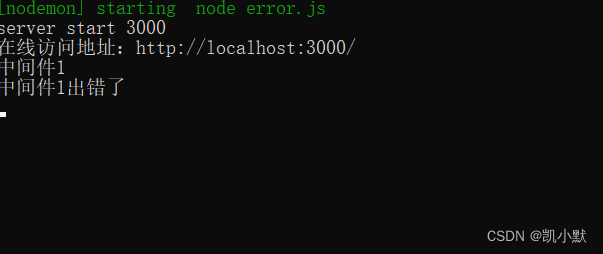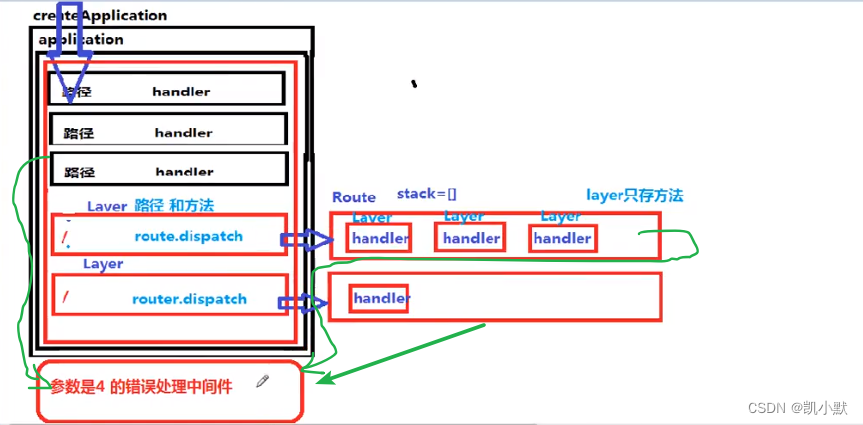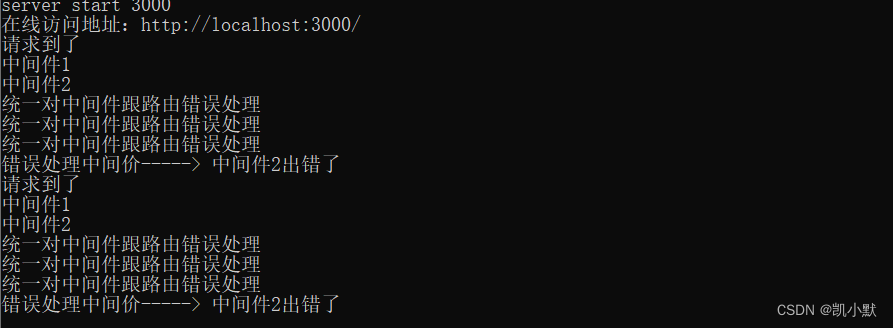手机如何做api网站南宁网站建设公司排行
上一节实现了 express 的中间件,这一节来实现错误处理中间件
执行某一步出错了,统一规定调用 next 传递的参数就是错误信息
先看 express 实现的demo
const express = require("express");
const app = express();app.use("/", (req, res, next) => {console.log("中间件1");// next();next("中间件1出错了");
});app.use("/", (req, res, next) => {console.log("中间件2");next();// next("中间件2出错了");
});app.use("/", (req, res, next) => {console.log("中间件3");next();// next("中间件3出错了");
});app.get("/",(req, res, next) => {console.log("路由1");next();},(req, res, next) => {res.end("出错了 *****");}
);app.listen(3000, () => {console.log(`server start 3000`);console.log(`在线访问地址:http://localhost:3000/`);
});
然后去访问:http://localhost:3000/

错误处理中间价,里面必须要有 4 个 参数(取函数的长度),放到栈的最底下
app.use((err, req, res, next) => {res.end(err);
})

下面实现处理逻辑
router/index.js
const url = require("url");
const Route = require("./route");
const Layer = require("./layer");
const methods = require("methods");function Router() {// 维护所有的路由this.stack = [];
}Router.prototype.route = function (path) {// 产生 routelet route = new Route();// 产生 layer 让 layer 跟 route 进行关联let layer = new Layer(path, route.dispatch.bind(route));// 每个路由都具备一个 route 属性,稍后路径匹配到后会调用 route 中的每一层layer.route = route;// 把 layer 放到路由的栈中this.stack.push(layer);return route;
};methods.forEach((method) => {Router.prototype[method] = function (path, handlers) {// 1.用户调用 method 时,需要保存成一个 layer 当道栈中// 2.产生一个 Route 实例和当前的 layer 创造关系// 3.要将 route 的 dispatch 方法存到 layer 上let route = this.route(path);// 让 route 记录用户传入的 handler 并且标记这个 handler 是什么方法route[method](handlers);};
});Router.prototype.use = function (path, ...handlers) {// 默认第一个是路径,后面是一个个的方法,路径可以不传if (typeof path === "function") {handlers.unshift(path);path = "/";}// 如果是多个函数需要循环添加层for (let i = 0; i < handlers.length; i++) {let layer = new Layer(path, handlers[i]);// 中间件不需要 route 属性layer.route = undefined;this.stack.push(layer);}
};Router.prototype.handle = function (req, res, out) {console.log("请求到了");// 需要取出路由系统中 Router 存放的 layer 依次执行const { pathname } = url.parse(req.url);let idx = 0;let next = (err) => {// 遍历完后没有找到就直接走出路由系统if (idx >= this.stack.length) return out();let layer = this.stack[idx++];if (err) {console.log("统一对中间件跟路由错误处理");// 找错误处理中间件if (!layer.route) {// 如果是中间件自己处理layer.handle_error(err, req, res, next);} else {// 路由则跳过,继续携带错误向下执行next(err);}} else {// 需要判断 layer 上的 path 和当前请求路由是否一致,一致就执行 dispatch 方法if (layer.match(pathname)) {// 中间件没有方法可以匹配,不能是错误处理中间件if (!layer.route) {if (layer.handler.length !== 4) {layer.handle_request(req, res, next);} else {next();}} else {// 将遍历路由系统中下一层的方法传入// 加速匹配,如果用户注册过这个类型的方法在去执行if (layer.route.methods[req.method.toLowerCase()]) {layer.handle_request(req, res, next);} else {next();}}} else {next();}}};next();
};module.exports = Router;
layer.js
function Layer(path, handler) {this.path = path;this.handler = handler;
}Layer.prototype.match = function (pathname) {if (this.path === pathname) {return true;}// 如果是中间件,进行中间件的匹配规则if (!this.route) {if (this.path == "/") {return true;}// /aaaa/b 需要 /aaaa/ 才能匹配上return pathname.startsWith(this.path + "/");}return false;
};
Layer.prototype.handle_error = function (err, req, res, next) {if (this.handler.length === 4) {// 调用错误处理中间件return this.handler(err, req, res, next);}next(err); // 普通的中间件
};
Layer.prototype.handle_request = function (req, res, next) {this.handler(req, res, next);
};
module.exports = Layer;
route.js
const Layer = require("./layer");
const methods = require("methods");function Route() {this.stack = [];// 用来描述内部存过哪些方法this.methods = {};
}Route.prototype.dispatch = function (req, res, out) {// 稍后调用此方法时,回去栈中拿出对应的 handler 依次执行let idx = 0;console.log("this.stack----->", this.stack);let next = (err) => {// 如果内部迭代的时候出现错误,直接到外层的 stack 中err && out(err);// 遍历完后没有找到就直接走出路由系统if (idx >= this.stack.length) return out();let layer = this.stack[idx++];console.log("dispatch----->", layer.method);if (layer.method === req.method.toLowerCase()) {layer.handle_request(req, res, next);} else {next();}};next();
};
methods.forEach((method) => {Route.prototype[method] = function (handlers) {console.log("handlers----->", handlers);handlers.forEach((handler) => {// 这里的路径没有意义let layer = new Layer("/", handler);layer.method = method;// 做个映射表this.methods[method] = true;this.stack.push(layer);});};
});module.exports = Route;
测试demo
const express = require("./kaimo-express");
const app = express();app.use("/", (req, res, next) => {console.log("中间件1");next();// next("中间件1出错了");
});app.use("/", (req, res, next) => {console.log("中间件2");// next();next("中间件2出错了");
});app.use("/", (req, res, next) => {console.log("中间件3");next();// next("中间件3出错了");
});app.get("/",(req, res, next) => {console.log("路由1");next();},(req, res, next) => {res.end("出错了 *****");}
);// 错误处理中间价
app.use((err, req, res, next) => {console.log("错误处理中间价----->", err);res.end(err);
});app.listen(3000, () => {console.log(`server start 3000`);console.log(`在线访问地址:http://localhost:3000/`);
});

